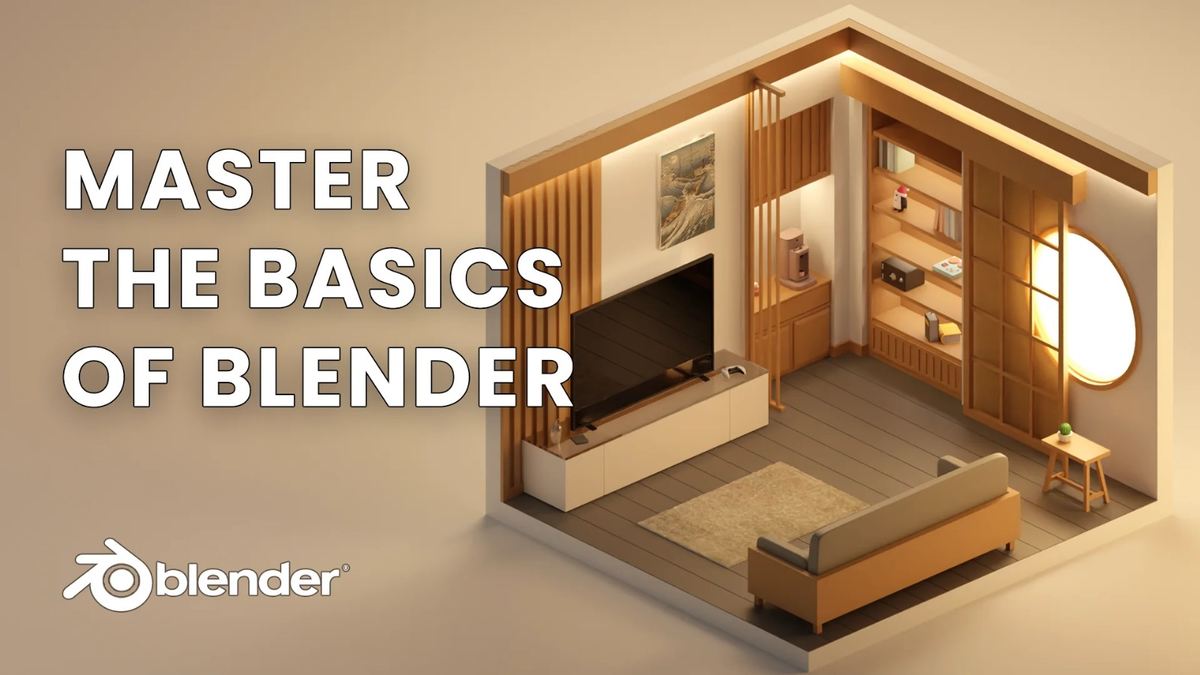Are you ready to dive into the world of 3D Blender? Our comprehensive, step-by-step video series is perfect for absolute beginners or those looking to sharpen their skills. This tutorial will guide you through everything you need to know to make your creative ideas come alive using Blender, a free and open-source 3D creation suite.
Follow our six-part video series to learn how to navigate Blender, manipulate 3D models, apply materials, master lighting, render your scenes, and even create your own projects. Whether you’re a hobbyist or aspiring professional, these tutorials will help you develop a strong foundation in Blender 3D.
Key Takeaways: What You'll Learn from the beginner Series
- Navigation in Blender: Understand how to set up your workspace and navigate Blender’s interface to optimize your workflow.
- Working with 3D Models: Learn how to manipulate 3D models, including scaling, rotating, and transforming them within your scene.
- Applying Materials: Discover how to use materials to enhance the appearance of your 3D models.
- Lighting Your Scene: Explore different lighting techniques to make your scenes visually stunning.
- Rendering and HDRI: Understand rendering basics, including HDRI settings, to create high-quality 3D models.
- Practice with a Free 3D Room Model: Put your skills to the test by practicing with a provided 3D room model.
Episode Breakdown: Learn from Each Part of the Series
1. Navigating Blender: Your First Step in 3D
In the first part of the series, we introduce you to the Blender interface. If you've just downloaded Blender, this tutorial is for you! Learn how to set up your workspace, navigate through various tools, and get familiar with the basic controls. A good understanding of Blender's interface is the foundation for your 3D journey.
Key Focus: Understanding the 3D viewport, toolbar customization, and essential navigation shortcuts.
Practical Tip: As a beginner, it's essential to use Blender’s default layout until you are comfortable. This will help you get acquainted with the most commonly used panels and tools, such as the 3D viewport, outliner, properties panel, and timeline. Consider using the “Emulate 3 Button Mouse” option if you’re using a laptop touchpad.
Additional Resources: The Blender manual and community forums are excellent places to explore keyframe techniques for your 3D models. They offer detailed documentation and real-world solutions from other users.
2. Working with 3D Models: Sculpt and Shape Your Ideas
Now that you’re familiar with the Blender interface, the second tutorial focuses on working with 3D models. You'll learn how to import models, manipulate them, and use basic transformations like scaling, rotating, and moving. We’ll explore different ways to create and modify objects to match your creative vision.
Key Focus: Object manipulation, transformations, and effective model management.
Practical Tip: Practice manipulating primitive objects like cubes, spheres, and cylinders. These objects will help you understand the basics of 3D space and transformations, essential for any animator. Experiment with different modifiers like Subdivision Surface, Mirror, and Boolean to see how you can alter shapes quickly.
Bonus Content: For those interested in going beyond the basics, check out Blender’s sculpting tools, which offer a more freeform approach to modeling. Sculpting is perfect for organic shapes like characters, creatures, or even terrain.
3. Materials and Textures: Bringing Your Models to Life
The third part of our series dives into materials and textures. You’ll learn how to apply different materials to your models and adjust their properties to get the desired look. We'll also introduce you to some free models so you can practice working with materials
Key Focus: Understanding shaders, textures, and where to find free material resources for your 3D in Blender.
Deep Dive into the complexities of 3D in Blender: Materials in Blender are defined using nodes—a visual system that lets you control how surfaces interact with light. Start by learning the basic shader types, like Principled BSDF, which can mimic a wide range of materials, from metals to glass. Understanding how to use nodes effectively is crucial for creating realistic textures.
Practical Exercise: Try creating a simple object, like a coffee cup, and experiment with different materials. Use the Principled BSDF shader to create a ceramic texture, and then add a separate material for the coffee inside. This will help you understand how to assign multiple materials to different parts of a single object.
Additional Resources: Sites like Texture Haven, CC0 Textures, and Poliigon offer free and paid textures that you can use in your Blender projects, enhancing your animation features. Make sure to explore them to find the perfect materials for your scenes, enhancing your animation skills.
4. Lighting: Creating Atmosphere and Depth
Lighting can transform a good model into a great one, especially when used effectively by an animator. In this tutorial, we'll discuss the various lighting options available in Blender, including point lights, spotlights, and area lights. Learn how to position your lights effectively to create the right mood and depth for your 3D model.
Key Focus: Different types of lights, how to set them up, and tips for effective lighting in 3D scenes.
Deep Dive: Understanding the types of lighting is fundamental to creating the right atmosphere. Experiment with different lighting setups such as three-point lighting, which is a standard in film and animation. Learn about light falloff and shadows to make your scene more dynamic and visually interesting.
Practical Exercise: Recreate different times of day in your scene—morning, noon, and night. Adjust the light colors, intensities, and positions to see how these changes affect the mood. This is a great way to learn how lighting can influence the story and emotions conveyed in your 3D, particularly through motion paths.
Additional Resources: HDRI Haven provides free high-dynamic-range images that can be used to create realistic environmental lighting in Blender. This is especially useful for exterior scenes or when you want to create a sense of place and atmosphere.
5. Rendering and HDRI: Get the Best Results
Rendering is where your hard work comes to life. In this tutorial, we cover the basics of rendering in Blender, including using HDRI (High Dynamic Range Imaging) to enhance your scenes. Learn how to adjust your render settings for the best quality and how to use HDRI for realistic lighting and reflections.
Key Focus: Render settings, HDRI setup, and achieving high-quality outputs.
Deep Dive: Blender offers two main rendering engines: Cycles and Eevee. Cycles provides photorealistic results using path tracing, while Eevee offers faster real-time rendering, suitable for previews or stylistic animations. Understanding the pros and cons of each engine is crucial for choosing the right one for your project.
Practical Tip: Start with Eevee to get quick previews and then switch to Cycles for your final render if photorealism is needed, especially in complex animations. Adjust the sampling settings to balance render time and quality. Experiment with denoising features to reduce noise in your renders without increasing render time significantly.
Bonus Content: Explore Blender’s compositor to add post-processing effects like color grading, lens flares, and depth of field. This can enhance your renders and add a professional touch to your animations, showcasing advanced animation features.
6. Practice with a Free 3D Room Model: Your Turn to Shine
In the final part of our series, we provide a free 3D room model so you can practice everything you’ve learned. This hands-on approach will help you solidify your skills, allowing you to experiment with different techniques and workflows.
Key Focus: Applying all learned skills to a practical project, encouraging experimentation, and creativity.
Practical Tip: Use the provided 3D room model to practice lighting setups, material applications, and camera angles. Challenge yourself by adding new elements to the room or creating a short 3D within the space, such as a bouncing ball, rotating fan, or moving light source.
Additional Resources: Check out Blend Swap, a site where Blender users share free models, scenes, and assets. You can download these to study how other artists set up their projects and learn new techniques.
Final Thoughts: Practice, Patience, and Perseverance
Mastering Blender takes time and dedication. Remember, the key to success is regular practice and a willingness to learn. As you work through these tutorials, don’t be afraid to make mistakes—they are a crucial part of the learning process. The Blender community is vast, supportive, and filled with countless resources. Embrace the challenge, and soon, you’ll be creating stunning 3D with ease!
Expanding Your Knowledge: Continuing Your Blender Journey
- Join Blender Communities: Engage with communities like Blender Artists, Blender Stack Exchange, and the Blender subreddit. These platforms provide opportunities to ask questions, share your work, and receive feedback from other Blender users.
- Participate in Challenges: Websites like CG Cookie and BlenderNation frequently host modeling, texturing, and animation challenges. These challenges help you push your skills further and learn from others.
- Follow Blender Developers: Stay updated with the latest features and changes in Blender by following the Blender developers’ blog and joining Blender Today’s YouTube streams. Keeping up with updates will ensure you're using the newest and most efficient tools for your animation in Blender.
Conclusion: Start Your Blender Journey Today!
By the end of this tutorial series, you'll have a strong foundation in Blender's 3D tools and techniques. Whether you're creating your first 3D or looking to improve your skills, these videos are designed to guide you every step of the way.
Don’t forget to subscribe to our YouTube channel and check out the full playlist for a more interactive learning experience focused on 3D skills. Happy animating!
If you're excited to get started, head over to our YouTube channel and subscribe to access all six tutorials for free. Share your progress in the comments, and don’t forget to like and share if you found this helpful!



